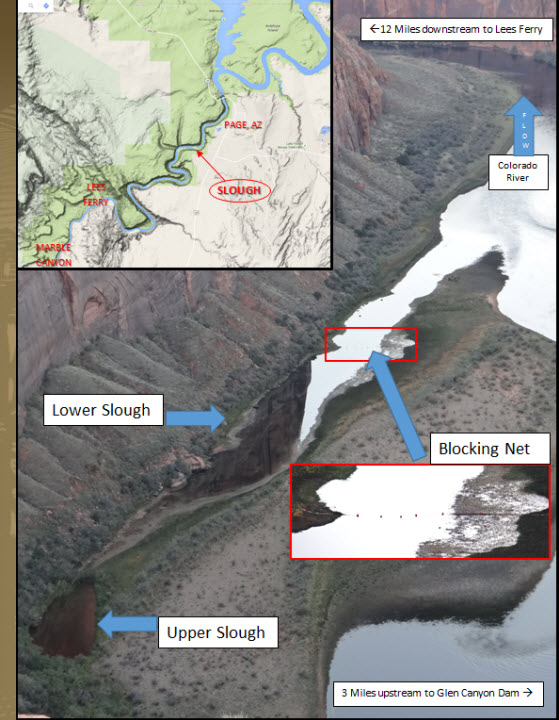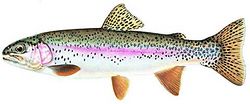Updates
|
2016
The NPS is hosting a webinar on October 27, 2016 for stakeholders and interested parties to develop a range of options for Long Term Risk Reduction for Green Sunfish in the -12 RM sloughs, and other invasive fish species and locations in the Lees Ferry Reach of Glen Canyon National Recreation Area. This 'brainstorming' session will provide the basis for developing a range of alternatives to be analyzed in a Long Term Risk Reduction Plan and Environmental Assessment to be completed and implemented by October 2017. For more information contact Melissa Trammell at [email protected]
Sampling results from September 1-2, 2016
- 822 GSF total (806 in the upper slough, 16 in the lower); three YOY size classes + adults
- 22 CRP total (21 in upper, 1 in lower)
- 7 larval salamanders (all upper)
- 3 RBT (all lower)
- temperature in upper slough- 20.7 C (9/1)
- temperature in lower slough- 16.7 C (9/1, upper portion)
In August 2016, NPS reported the results of a survey they did in response to a report from AZGF that there may be green sunfish again in the Upper Slough in Glen Canyon. An infestation of green sunfish in this slough was why an HFE was not held in the fall of 2015. NPS reported on 8/16/2016: "Two Grand Canyon National Park technicians made a quick sample in the Upper Slough with a backpack electrofisher on Friday (August 12). Due to a river emergency downstream, they had limited time on site, but completed one sample (574 seconds) along the muddy shore on the river side of the slough. They captured 26 green sunfish and saw many more. Some captured green sunfish were in the 20 mm size range. A block net is still installed between the sloughs, but is compromised at current flows." NPS, Reclamation, USFWS, AZGF, and GCMRC are organizing to come up with both a short-term plan that addresses this latest infestation and to come up with a long-term fix for this problem. The hope is to have this addressed in some fashion before the end of the current HFE window as to not interfere with the possibility of conducting an HFE this fall.
2015
In July, 2015 AGFD biologists discovered an unusually large, reproducing population of invasive green sunfish in the slough. Green sunfish are prolific, with a single female producing up to 10,000 eggs. They are also voracious predators of native fish and their eggs. Biologists with the AGFD, NPS, USGS, FWS, and BOR determined that green sunfish pose a threat to native fish including the humpback chub (Gila cypha). A rapid response action is necessary to eradicate the population of sunfish before it spreads downstream into critical habitat for the endangered humpback chub. (2015 NPS Press Release)
Results from 2015 removals
- July 6: 43 (all lower slough)
- August 12-14: 954
- August 27-28: 2,574
- October 27-29: 775 (39 lower, 736 upper)
- November 15: 1,967 (chemical treatment; 180 lower, 1,787 upper)

|
|
Links and Information
|
|
|
Presentations and Papers
|
|
2016
2015
|
Acceptable Risk Calculations for GSF
|
|
Email from Melissa Trammell (NPS) 9/7/16:
I've been looking at the question of a scientifically derived and defensible acceptable risk number of Green sunfish remaining in the lower slough before a potential triggered HFE this year. To support my analysis, I've attached a ppt presentation by retired FWS biologist Pat Martinez. His data and analyses are based on a number of illegal introductions of fish into various water bodies in the upper basin, and how many introductions, and fish per introduction were necessary before populations of the introduced species were established. The species examined were walleye, smallmouth bass and northern pike; invasive species of concern in the upper Colorado River Basin. Green Sunfish are most analogous to smallmouth bass in this example. If you look at slide 11, the key numbers are that it takes a mean of 1.25 adult fish, and a minimum of 0.25 SMB per surface acre of receiving water body to establish a population in a new water. He applied this value to rivers, particularly the Yampa River, by looking at total river miles times average width to get total surface acres. (the point of the analysis was that the Program's removal targets for smallmouth bass for that river were about the same as the mean number needed for establishing a population, which indicated we needed to adjust our targets down).
Also note that the calculation below is a very conservative estimate, since this species is less likely to establish a population in a river environment than a lake or pond, also, the calculation assumes the fish are adult, which is not the case for the GSF in the sloughs - they are primarily young of year. If we do the calculation for the Colorado River below the sloughs, down to the Little Colorado River, which is our area of primary concern, and apply the minumum of 0.25 fish per surface acre, you get a result that 656 fish could establish a population. Given David Ward's calculation that we captured about 12% of the total number of GSF present on a single pass last year, that means a theoretical one-pass capture of 78 fish likely would represent a total population in the lower slough of 656 fish. Clay only captured 4 (counting the ones in the little channel) in 40 minutes of sampling, that should indicate that there were only about 33 fish present in the lower slough when Clay sampled. Subsequent sampling on Sept 1-2 only produced 10 GSF; much lower densities than this risk assessment would consider problematic Last year, in the lower slough, we removed about 1800 GSF before the treatment, and collected about 200 afterwards. AGFD suggested 100 fish as an upper limit, and Ken suggested 5 mature fish/hour electrofishing. These are both much more conservative targets than the above calculations.
In summary, I'd suggest that a very conservative value for the number of fish in the lower slough remaining before a triggered HFE would be 300 GSF of any size, about 50% of the value calculated from Martinez' analysis. This number would either be calculated from depletion estimates as we progress through the removal efforts, or by using 12% as the capture probability, thus a final pass should produce less than 36 total fish (12% of 300). If the number of fish remaining in the lower slough after all mechanical removal efforts is greater than that, we would move towards implementing a rotenone treatment.
Please don't hesitate to call or email if you have questions or concerns.
Melissa
|
Other Stuff
|
|

|
|





